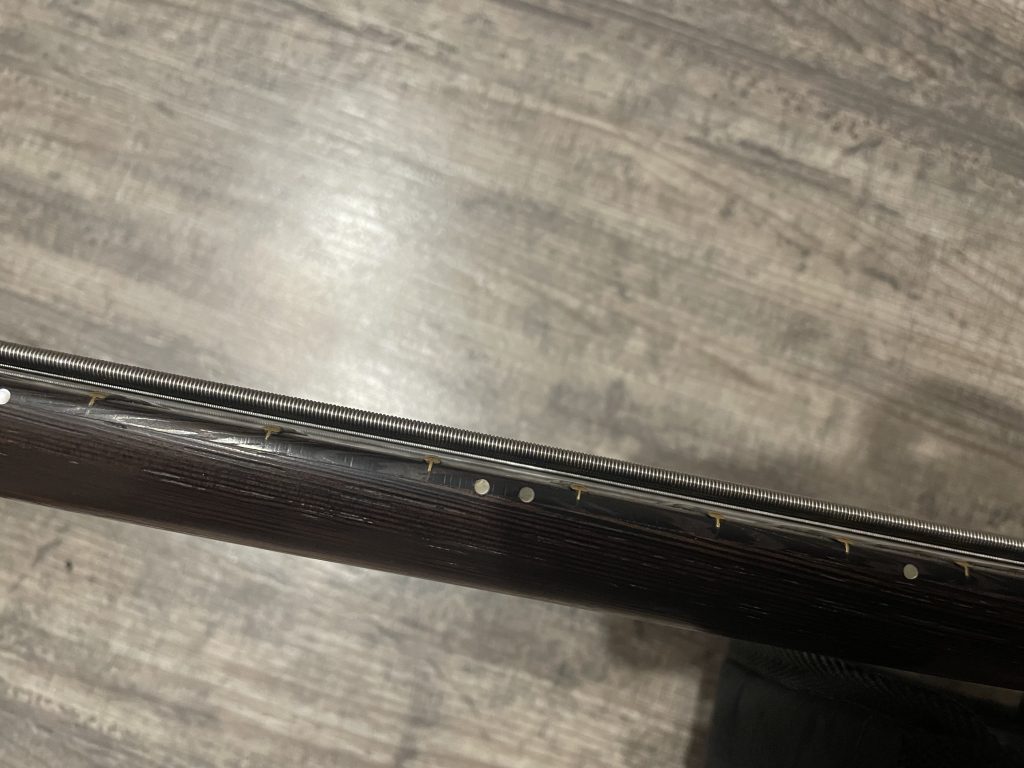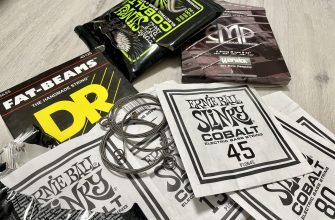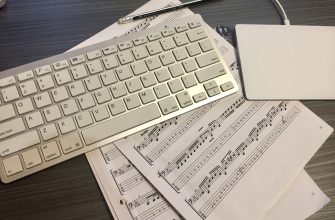Just in case, I’ll give you a definition. Action is the distance between the fingerboard and the strings. It is usually measured around the 12th fret. The string is held down at the moment of measurement on the first fret at that time. Action affects at once the sound of the bass and the playability of the bass. What action to choose for the bass for the beginner is not obvious. I have gone some way to find the answer to what is the best action for a bass guitar. It was a journey from very high to low string placement, and then back to higher, but closer to medium. The most important thing is that you don’t need to start from some specific values in mm or inches. You need to try a few options, play around, and record what you get. The action is quite easy and quick to change by raising or lowering the bridge, so it’s worth experimenting. I’m not going to repeat the basic rules, they were well explained by Marcelo Feldman https://www.youtube.com/watch?v=kxpMwsUK2IM. I will, however, write down some observations that are not obvious to everyone.
- If you play with a very low string arrangement, are happy with the sound, but have trouble controlling dynamics and keeping a clear tempo, a higher action may help. Yes, yes, that’s a bit counterintuitive. Lower strings are easier to strum, but harder to control. By making the action higher we are tightening the string.
- If the bass is well tuned, it’s comfortable to play. In that case, you usually don’t think about action. When you don’t like the sound, you turn up the EQ. But maybe it’s worth experimenting with the height of the strings? The optimal combination of clicking from the attack, tinkling against the fret, and balance with a clean sound makes for a beautiful sound. And different string models may require different settings.
- For concert or rehearsal action can be higher than for playing in the studio or at home. When playing loudly together, you will unwillingly start digging the strings deeper. It’s not necessarily true, depends on the bassist’s temperament and playing technique, but it’s not rare. The sound becomes more aggressive and muddy. If necessary, this can be corrected by increasing the distance from the fingerboard to the strings.
- If the strings are new on the bass, but the sustain in the notes is short, you can try to make higher action, add tension. With low strings, some of the energy is lost to micro bumps on the fret. And even more importantly, the starting energy of the string vibration is less at low tension, we play more delicately. All in all, this is an additional direction for reflection and experimentation.
If you have several bass guitars, you can tune one with the strings low, the other higher, and the rest even differently. I only have one Warwick Thumb bass, so I tune it with universal action. I need a fair amount of string tension to control the evenness of my playing, while trying not to lose clicks from attacking the strings. This is achieved by experience. You can gradually raise or lower the bridge without tightening the locking screws and listen to what you get. Very convenient, at least in my Warwick Thumb, but in other brands and models it is also very easy. In some mechanisms, you have to raise each string separately, but it’s not much harder either.

Right now with Ernie Ball Cobalt strings, the distance around the 12th fret between the top surface of the fret and the bottom surface of the string is 3mm (3/32″) for B and E strings. When I dig the strings, I have a clang and clicks, when I play weaker, I can get a clean sound. Very comfortable. Again. This is the best option for me, but for someone else it may not be appropriate.
For those who want more specific numbers, here are the results of a poll on Talkbass forum. A total of 102 respondents took part in the pool. The results of course cannot reflect the height of strings for all the bass players of the world, but as some examples quite.
What is the distance between the top of the fret to the bottom of the string at your 12th fret E-s?
- Less than .125″ (<3.2 mm) – 57.8%
- between .125 and .150″ (3.2 – 3.8mm) – 20.6%
- between .150 and .188″ (3.8 – 4.8mm) – 9.8%
- between .188 and .200″ (4.8 – 5.1) – 9.8%
- above .200″ (>5.1%) – 2.0%
I made a compilation of interesting, in my opinion, information about action from famous bassists and instrument manufacturers.
- Scott Devine, Scott’s Bass Lessons – 1.5 mm at G-string, 2 mm at E and B strings. Low action case https://youtu.be/bGtjMNtr4Nk?t=298.
- John Patitucci uses high action. (According to Janek Gwizdala)
- Janek Gwizdala says that high action gives more tonal possibilities. I recommend https://youtu.be/U4sDePCciTo?t=24.
- Roger Sadowsky. Basic Tuning. Clamp the string on the first fret and measure on the 12th. G string – 2/32′ or 1.59mm, B string – 3/32′ or 2.38mm.
- Fodera Guitars: (From the bottom of the G string above the 24th fret. The string is clamped on the first fret) Low – 2/23″ (2.2 mm), Med – 3/32″ (2.4 mm), High – 4/32″ (3.2 mm).
Summary
Bass guitar action is adjusted for each individual bass player, instrument and string model through experimentation. First and foremost, you should be guided by your hearing and how you feel about playing. Any rules are just recommendations, they can be broken.




